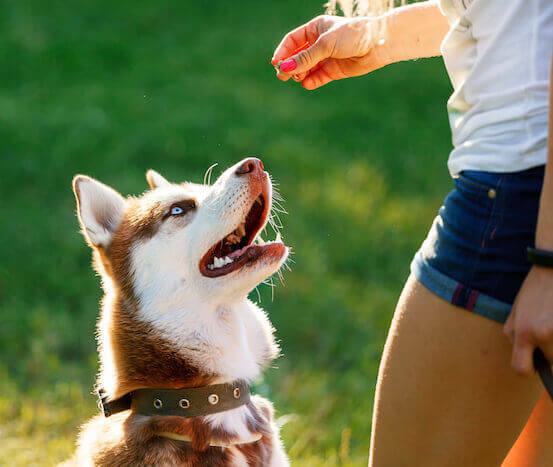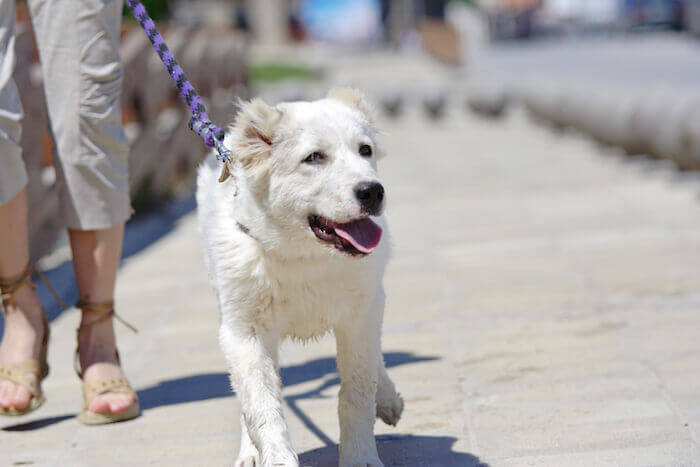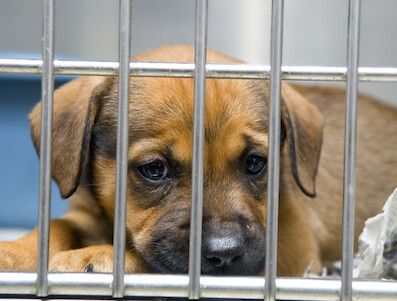When it comes to training your new puppy, there are generally two schools of thought. One school of thought, often referred to as dominance training, centers around the inherent pack mentality of dogs. The idea is that a dog looks to his or her person to assert dominance. Once that dominance is established, the dog is happy to follow. According to this theory, the absence of a person asserting dominance results in the puppy asserting dominance.
Commands & Rewards | Obedience School | On Leash | Socialize | Crating | Anxiety
This theory has been the bedrock for the go-to puppy training methods for several years. However, there have been loads of recent research that suggests that training based on this theory is highly flawed and ineffective. Modern research suggests that dominance theory has been misapplied to the relationships between individual dogs and their humans. In short, dogs act differently, with different motivations when taken out of the pack. Furthermore, research suggests that dogs respond most effectively to positive reinforcement and reward. Here are some tips to get you started with your puppy’s training:
Be consistent
Consistently is probably the most important thing to consider when training your puppy. Make sure you develop a complete and comprehensive list of ‘do’s’ and ‘don’ts’ for your puppy. Make sure to consistently apply the appropriate rewards or corrections when your dog engages in do and don’t behave, respectively. Nothing confuses a dog more than inconsistency. For instance, if you do not want a puppy to jump on your couch, never allow your puppy to jump on the couch. Imagine the confusion a puppy would feel if one night you allow him or her to lie on the couch and the next night you are yell at him or her for jumping up on the couch.
Reward, reward, reward
The key to effective training lies in making your puppy feel happy and fulfilled when he or she listens to your commands. You want your puppy to know that there is something in it for him or her if he or she continues a ‘do’ behavior or discontinues a ‘don’t’ behavior. The reward can be your dog’s favorite treat or simply affectionate praise with a scratch or rub in his or her favorite spot. Make your dog feel positive about his or her decision to listen to you.
Further Reading
Dog Care Guide
Caring for Dog Breeds
Puppy Vaccinations
Pet Insurance Basics
Be specific with your commands
It is not uncommon for a person to use the term “no” in an attempt to get a dog to stop a certain behavior. There is nothing inherently wrong with “no”, but it can often lead to confusion. When “no” is applied to a litany of ‘don’ts’, a puppy may become confused and unclear about his or her expectations. A puppy may think: “what am I supposed to be doing?” Try to be more specific with your commands and with your expectations. For instance, if a dog jumps on you, instead of saying “no”, tell the dog to sit. Also, if you do not want your dog to jump on the couch, instead of saying “no”, say “down”. Varying your commands for different ‘do’s’ and ‘don’t’ will go a long way in helping your puppy to understand your expectations. Furthermore, keep your commands as simple as possible. Keep your commands to one or two words. Long phrases or sentences can be too much for a puppy to process and therefore there use would be counterproductive. And don’t forget to positively reinforce with praise or treats!
Types of Reward
As mentioned earlier you can use treats and praise as rewards. However, you want to make sure that your puppy truly enjoys the rewards you are giving. Make sure that the treats you use for rewarding your puppy are treats that your puppy not only likes but absolutely adores. Also, when giving praise and pets, make sure you are giving your puppy his or her rubs in a favorite spot. Some dogs love belly rubs, others like pets behind the ear. Dogs are like people in their varying likes and dislikes, so you can imagine how counterproductive it would be to receive a “reward” that you do not like. It is also important to vary your rewards. Use several different types of your puppy’s favorite treats as rewards. This will ensure that your puppy does not get tired of a particular treat. Again, just like people dogs can grow tired of certain foods. What was once an amazing treat could become just a run of the mill snack, if overused.
Help With Training
Training Clickers
Training Treats
Do not reward bad behavior
These one seems like it is obvious, but many people accidentally reward undesirable behavior. For instance, if barking is something on your ‘don’t’ list and your puppy barks to go outside, correct the barking before you let your puppy outside. You do not want to give your puppy the impression that you are rewarding behavior on your ‘don’t’ list.
Further Reading:
Meaning of Dog Behaviors
Cure a Sick Puppy
Should You Take Your Puppy to Obedience School?
Taking your puppy to a good obedience school is a worthwhile investment in your dog’s life as well as yours. In the past, it was recommended by experts to start formal training classes when the dog was about six months old. However, today, animal behaviorists recommend starting much younger because by six months, bad habits can be formed that are difficult to change. If your dog doesn’t have any health problems, you can start formal classes as early as seven to eight weeks.
According to the American Veterinary Society of Animal Behavior (AVSAB) most puppies can start socialization classes at seven to eight weeks. They should have had at least one set of vaccines and a deworming seven days before the first class. If adequate socializing does not take place during the first two or three months, some of the behavioral issues that may occur are phobias, fears, avoidance, and aggression. These could last throughout the dog’s life. In classes by the American Kennel Club, the instruction is tailored for the age of the puppy. This type of training lasts for six weeks at which time the puppy is ready to learn new skills.
How to Train a Puppy to Walk on Leash
Dogs love to explore the great outdoors and examine every nook and cranny, and they may consider a leash as an impediment to this. They may pull ahead since they can walk faster than their human can, or they may lag behind and need constant reminders to get going. Puppies need to be trained on how to walk on a leash because the leash constrains their natural inclinations. There are several methods to teach your dog to walk with you while on a leash.
Every time you go out, consider it a training session. You should make several, regular sessions every day and make them short but sweet. Your dog should enjoy it. These training sessions may not give your dog the exercise it needs, so you need to find other ways for your dog to get exercise. It is recommended to let your dog exercise before you have a leash training session. You will need to have some treats handy for your dog. Soft treats are preferred because they can be eaten quickly so the training can continue.
On leash-training walks, you should walk quickly. When you move at a faster pace, your dog will pay more attention to you than to the enticing odors along the way.
Your dog must be calm before your leash training walk. If it jumps around because it knows it’s going out, wait until it becomes calm with all four feet on the ground. Only attach the lease when your dog is calm and standing on all four feet. You may need to do this several times.
Advice on Socializing a Puppy with other Dogs or small children
Your dog needs to learn that it can live happily with people and other dogs. This is called socialization and can lead to an outgoing and confident dog. Socialization starts at birth when the puppy is vulnerable to good and bad experiences. It is important to expose your puppy to other people and animals so it learns to accept them. If puppies have positive experiences before they turn 16 weeks, they are less likely to develop fear.
You can start socialization training as soon as you bring your puppy home by inviting friends over, allow friendly dogs into your home, only visiting houses where the people and dogs are friendly to other dogs, and not allowing your dog to run up to unknown dogs.
How to Crate Train a Dog
Crate training is valuable for managing your dog during the times it is unsupervised for long periods. Some people crate their dogs when they leave the house. All aged dogs can be crate trained, but it is easier when they are young. You should start with the appropriate size crate. It shouldn’t be too big, as this will entice the dog to urinate in one corner. Even if your puppy is a large breed, start with a small crate.
Start by putting the crate near you or in a place where people gather so it seems normal and not isolated. Create an inviting space inside the crate with a soft blanket and toys that your dog likes. Don’t lock the door at first. Just let your dog go in and out. You can place treats in the back of the crate so your dog has to go inside to get them. You can speak to your dog to encourage it to enter the crate.
Once your dog goes in and out of the crate, you can start feeding it there. When it is busy eating, you can close the door. Only close the door for short periods at first. Never give treats if your dog whines, but you can give treats when it stops whining.
Further Reading
Treat Anxiety Issues
Crate Training Basics
How to Curb Separation Anxiety
Separation anxiety is common in dogs and has very specific symptoms. The dog may bark and howl, destroy furniture and urinate and defecate inside the house when the owner is gone. This behavior may start when you pick up your keys or open the door to leave. It may be simply bad behavior or symptoms of distress. The anxiety is triggered because you are leaving them alone in the house and they may be worried that you won’t come back. Some tips for curbing your dog’s behavior are:
- Keep it busy so it doesn’t follow you around the house
- Pick up your keys and open and close the door without going anywhere
- When you do go out, leave a radio or the TV on so the house doesn’t seem so empty
- Make sure you spend at least two hours a day with your dog. If this isn’t possible, a dog walker or doggy day care may be a good idea
- If your dog has had obedience training, it may be less likely to develop separation anxiety in the first place



